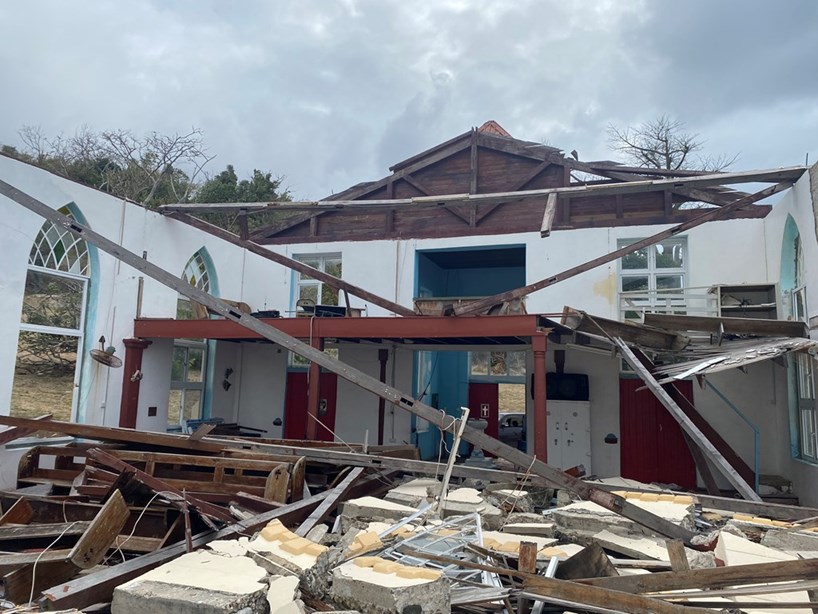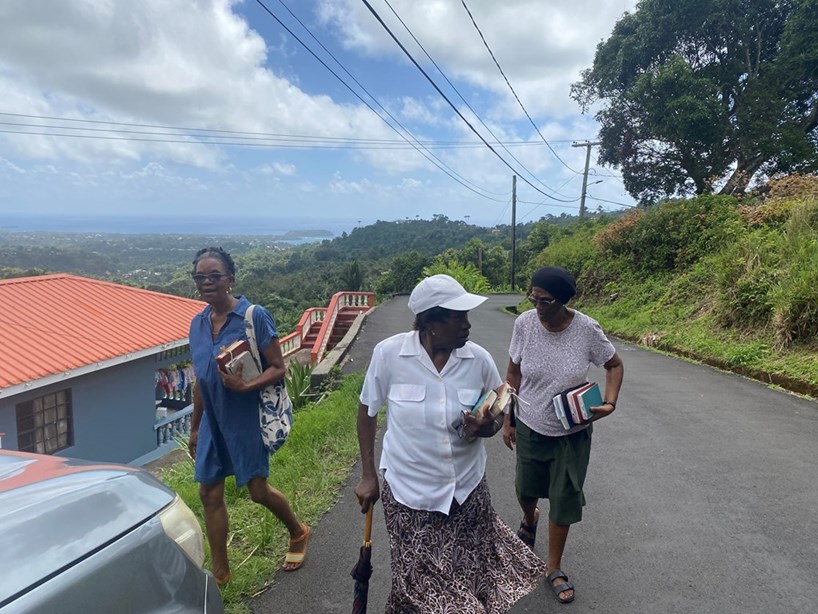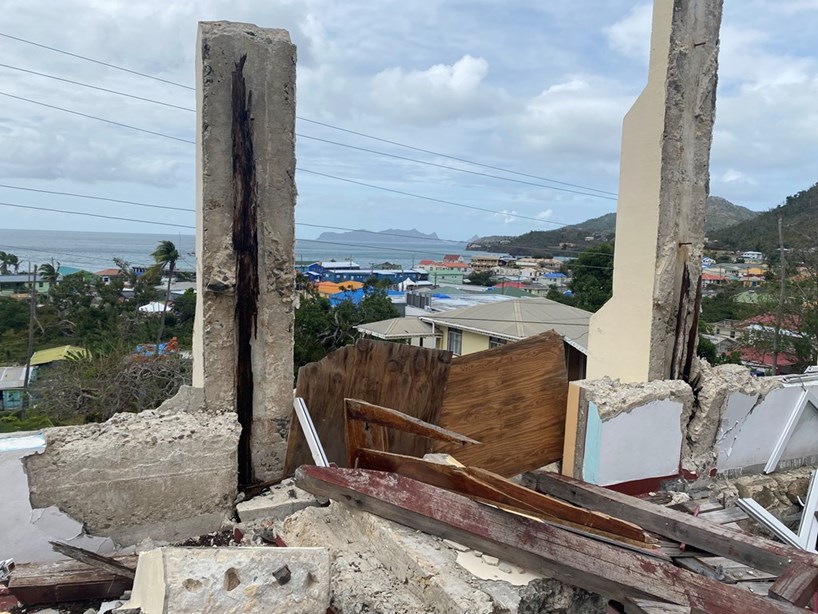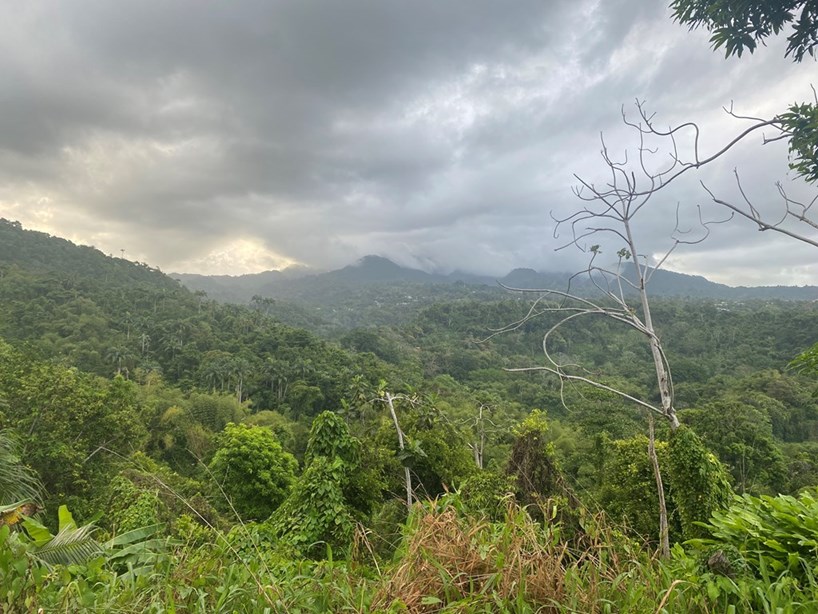SEVERAL of the Windward Islands were badly damaged by Hurricane Beryl last July (News, 5 July 2024). The Bishop, the Rt Revd Leopold Friday, had been one of my students at Codrington Theological College, in Barbados, where I taught in the early 1980s.
He asked whether I was able to offer any interim ministry, as some of the affected parishes were without resident priests. I retired four years ago, and was able to offer two months to visit. I went alone, not least in view of Bishop Friday’s offer to meet a housing need by slinging a hammock between two palm trees.
I was asked to cover a parish in the rural north-east of the island centred on the fishing town of Grenville, in Grenada. Beryl had done less damage there, but they had been without a resident parish priest for seven years. Like St Andrew’s, the rectory had also become unusable, though both were very fine buildings.
I arrived on 25 February, and spent a night with the Archdeacon, the Ven. Michael Marshall, and his wife, Curleen, for an introductory briefing. Michael has a huge amount of work, running the biggest Anglican parish, St George’s, as well, and holding the reins for any vacant parishes, which included St Andrew’s. We quickly became friends, and it was a joy to be with him both as he marked a birthday a few days later at a fund-raising parish evening, and then in St George’s as we marked our priestly ordinations together on Lady Day.
The following day, Frankie Gordon — not to be confused with his identical twin, Frank, both living in the same village, and both married to unpaid church workers — came down to fetch me in the parish “vehicle”. They always seem to be called “vehicle” — with equal emphasis on each syllable — rather than “car”. It was a large Nissan Frontier, a diesel 4×4 pick-up.
This was to be my car for the duration, and very reliable, once I acclimatised myself to its vast size and its disconcerting habit of throwing less light on full beam than it did on dipped headlights. I am old enough to find night driving increasingly tricky, even without such a peculiarity.
The drive from St George’s to St Andrew’s travels from the south-west to the beginnings of the north-east, winding sharply and steeply up and then down a large mountain range, Grand Étang. The scenery was spectacularly beautiful: abundant, lush, and verdant; it was proper mountain country, which was also tropical forest. I was to discover that the generosity of nature is reflected in the people.
I WAS delivered, not to a hammock, but to a charming, white, raised bungalow, with a downstairs apartment where Christopher lived. He didn’t speak much, and used a standpipe in the garden and a cooking fire fuelled by dried coconut husks. My part of the house was rather better equipped.
It was known simply as “Miz Pearly’s House”, with no other name or number — very few homes in Grenada have either, I discovered. It was opposite a blue-painted bakery, whose kneading machines would start at around 4.30 a.m. By 7 a.m., a delicious smell of baking bread would come wafting into my bedroom window.
 Jonathan MeyrickThe interior of Christ the King, Carriacou, after Hurricane Beryl
Jonathan MeyrickThe interior of Christ the King, Carriacou, after Hurricane Beryl
Next to it, on a hillside, more goats, sheep, and occasionally cows would be tethered on a hillside down which deluged a roaring stream during a morning of torrential rain. In the other direction, beyond the back garden, was Mount St Catherine, the largest mountain on the island. To the north, I could just make out the sea. There were peaceful, restorative walks in many directions.
A group of people were gathered there to meet me, all of whom were key lay members of the four congregations that made up the parish, currently meeting in two church buildings: Holy Innocents’, 25 minutes’ walk from my house in the village of La Digue, south of Grenville Town; and St Michael’s, in the even more rural village of Paraclete, just up the mountain from Paradise.
There is a committed PCC, with two churchwardens: Michael, from Paraclete, and Jenny, from St Andrew’s/Holy Innocents’. Both work: Michael (also a eucharistic minister) for the government, travelling a fair amount; and Jenny (also Mothers’ Union enrolling member), the head of St Andrew’s Anglican Primary School.
Jenny was a great mover and shaker, ensuring that things such as ironing boards (missing from the house) and new sheets were acquired. She also organised a weekly cleaner for me (Aurillia: very hard-working, and a great supporter of the church), and she was the first to offer me hospitality in her home.
Then there was Agnes, the sacristan — and so much more. Very little happened at Holy Innocents’ that didn’t involve her. She is a widow in her eighties, with a painful knee, but doesn’t give in to anything. On top of all that, she regularly cooked or baked things for me, and gave me and three colleagues from St Michael’s a wonderful day out. If only every church had someone like her!
There were two self-supporting deacons, one attached to each church, with complementary skills and gifts (Myrtle, a pastor by instinct, and Yvette, a gifted preacher); a loyal server (Aurillia’s granddaughter); and a great team of musicians, led by Ken and largely made up of his family.
They, and a small choir, operated at Holy Innocents’, where we had the larger of the congregations (55 and eight respectively on the first Sunday I was there — double in both churches by the time I left). In St Michael’s, Deacon Myrtle led us unaccompanied.
I became very fond of both places and both congregations. Across the parish, there were many villages of varying sizes and one town. I managed to find time to walk around in most of them, and it wasn’t long before most people knew who I was. That was boosted by schools ministry, by “visitations to the shut-ins” (as home communions were called), and by funerals.
IN THE parish, we had four schools, including one secondary, that took pupils up to their GCSE equivalents: St Andrew’s Anglican Secondary School (known as SAASS). My introduction to them came on Ash Wednesday, a week into my time there. Their hall cannot fit in everyone at once; so they used the verandas that run on two floors in front of every classroom.
I was set up in the upper-level angle, and everyone poured out of their classrooms on to the veranda. It was like a sea of people at high tide. Visibility can’t have been great for many of them, especially on the lower level. The service must have lasted about three-quarters of an hour, and there was chaos over the music — the wrong tune came out of a loudspeaker, and those who knew the right tune stuck to what they knew. They ranged from Year 7 to Year 11, and were amazingly attentive. Most of the school came up for “ashing”.
 Jonathan MeyrickSome of the team assisting on “shut-in” visitations
Jonathan MeyrickSome of the team assisting on “shut-in” visitations
Subsequently, SAASS invited me to do the opening prayer at the school athletics day, known as the “Sports Meet”. There was a splendid opening parade first, worthy of the Olympics, which marched from the school to a sports ground half a mile away, causing traffic jams that nobody seemed to mind.
Towards the end of term, I joined their fifth-form retreat to give an opening address. The fifth form was the top of the school, and the retreat happens just before they go into their final exams. Again, I was hugely impressed by their attentiveness, and by the quality of the pupil-led short service that came first.
There are also three Anglican primary schools, and I loved my ministry among them. Children are so refreshingly enthusiastic.
There were two Sundays when the Archdeacon asked me to go elsewhere in Grenada. On one of these, in the context of a long weekend there, I went to the small island of Carriacou. It has a single Anglican parish, also without a resident priest, and two Anglican congregations.
One, Christ the King, in the town of Hillsborough, worshipped in the oldest church on the island. The church was completely devastated by Beryl as she barrelled straight into that part of the town above the bay, and it was desperately sad to see it still in tatters. The congregation now meet in the Anglican secondary school.
Many houses on the island lost roofs, and many small businesses were blown away. There was, however, very clear evidence of restoration work going on, which was very moving. As I was taken round the island twice — once to see it all, and the second time on home-communion visits — I saw evidence everywhere of both devastation and the emerging restoration. Houses had to come first, of course, but seeing the church as the hurricane had left it was heart-wrenching.
That weekend, with a two-hour boat journey each way, in driving rain and choppy waters, marked a pivotal point, as Lent moved into its last two weeks. The emphasis moved from penitence to the themes of Passiontide. There was suddenly a huge increase in funerals — four in a week, averaging three hours each, not counting the subsequent wake.
The three hours of an average funeral broke down in the following way. First, an hour of eulogies and tributes, while the coffin waited, still half-open at the west door. On one occasion, a woman grieved for her grandfather very loudly, and rocked the coffin so violently that I thought she was going to pull it over.
 Jonathan MeyrickDamage inflicted by Hurricane Beryl to Christ the King, Carriacou
Jonathan MeyrickDamage inflicted by Hurricane Beryl to Christ the King, Carriacou
Second, the formal funeral service, which began with the closing of the coffin, and its reception and procession into the body of the church. Readings and prayers were usually given by members of the family, and a long sermon was expected from the priest. There would also be anything between four and six hymns.
Third, the coffin would be taken out and processed into the cemetery, often some distance away and uphill. The coffin went in an enormous white hearse with flashing purple lights and a loudspeaker on the roof. Reggae music blared out at full volume.
There would be a few cars following, and my colleagues insisted that mine be one of them. I tried saying that I would walk along with the countless others, but, luckily, I was overruled. The walking crowd would usually include several people dancing and swaying.
At the burial — sometimes in a public cemetery, but twice in a private garden — more hymns would be sung, generally about five or six of them, while everyone watched the grave filled in or helped. In one instance, someone was positively hindering: she clung on to the strap that lowers the coffin in an attempt to stop it descending. Several people rushed in to drag her off in time.
When I could, I would go to the wake as well. After all that emotional energy expended for several hours, a wake is much needed. At one, a very important piece of reconciliation took place between a mother and daughter.
I visited 14 “shut-ins” on Carriacou, 29 in the first three days of Holy Week back at St Andrew’s, and one after Easter. I had a team of assistants each day, who navigated, took turns reading the Gospel (with some fun over the pronunciation of “malefactors” — either “makers of males” or “evildoers”), and filled me in on family connections or the nature of the illness. These assistants made a huge difference, and gave so much of their time.
The following day, Maundy Thursday, I planned and wrote sermons for the next few days, before setting off for the day’s service. Perhaps it wasn’t surprising that, as I got to church, my body announced rather dramatically that I needed to stop. A “wobbly moment” in the vestry provoked four of my colleagues to state that they were taking me to the hospital near by.
An ECG and blood test later, I was sent to the ward for 24 hours of observation. I might have been there for longer, I suspect, because we were now into a four-day holiday weekend. I was determined not to let people down on Easter Day as well. I discharged myself on the Friday evening, and went back to work.
Easter Day itself was glorious — as it always is. Both churches looked lovely, and were much fuller than on my first Sunday. This was to be my last service at St Michael’s. Someone took a photograph of us all outside.
 Jonathan MeyrickA view of the landscape
Jonathan MeyrickA view of the landscape
Frankie had briefly taken back the vehicle while I was hospitalised, and so I was driven up to Paraclete by Cuthbert, someone else who had given me both hospitality and friendship. Cuthbert is a key figure in the Men’s Fellowship, both in the parish and more widely in the archdeaconry. He is winding down from that now, and, like others, is feeling the strain of being without a resident priest. A new appointment is badly needed. There are so many good people who blossomed this spring, but who need a new priest among them soon.
How can we help? Perhaps others — maybe the newly retired? — could offer themselves similarly? I know that Bishop Friday would be glad to hear such offers. Perhaps the new Church Commissioners’ Fund, set up in response to the awareness of the Church’s past involvement in the slave trade, could give some scholarships to Codrington Theological College? Some of the dioceses have people with a sense of vocation, but lack money to send them to Codrington.
As I waited for my wife, Rebecca, to arrive, and at a final, exuberantly joyous, farewell eucharist on the Sunday after Easter, such thoughts chased each other through my mind. Gloriously, after a very full few weeks back in the UK in the second half of May, I was invited to Northampton, to share in Oak Apple Celebrations at All Saints’. With two other English bishops and a Lord Lieutenant, I found myself being “shot at” by 17th-century musketeers.
There was no doubt that I was back in the English shires — although I cannot imagine not having Grenada and her lovely people in my heart for the rest of my life.
The Rt Revd Jonathan Meyrick is a former Bishop of Lynn (2011-21).
















